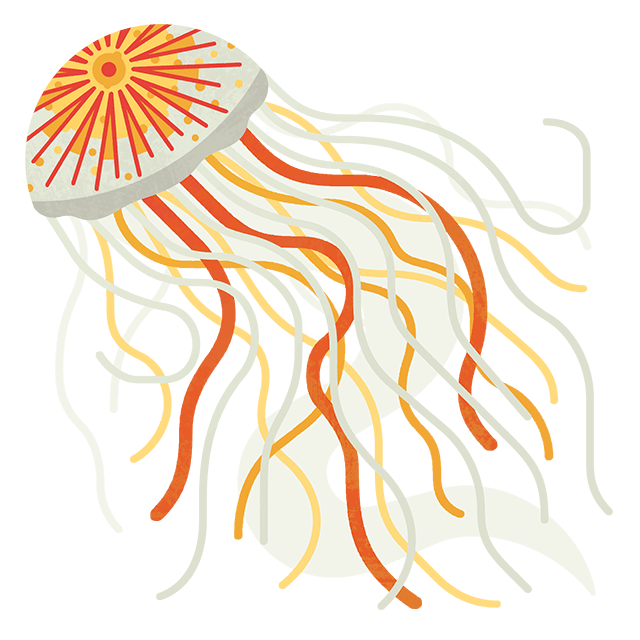
Jellyfish: Your questions answered
4 minute read
Curious about jellyfish? Get the lowdown on these fascinating creatures as we answer your top questions.
Is a jellyfish a fish?
Despite their name, jellyfish are not fish, but a type of invertebrate called a cnidarian. They’re jelly-like marine animals which have radial symmetry and sting their prey using cells on their tentacles called ‘cnidocytes’, which release powerful venom from microscopic barbed stingers whenever they're touched by a foreign object! Their name comes from the ancient Greek word ‘cnide’ meaning "nettle”.
Do jellyfish have brains?
Despite being living creatures, jellyfish don’t have brains – or hearts.
They do have a nervous system, however, with nerves at the base of their tentacles or a nerve net spread across their bodies. These nerves act as sensory organs that detect touch, temperature and smells. They also have neurons dispersed throughout their bodies.
Statocysts (balance organs) allow jellyfish to maintain their balance and orientate themselves by sending nerve impulses when they become tilted. Jellyfish then use reflexive movements to right themselves again.

Credit: James Lynott
Do jellyfish have eyes?
Most species of jellyfish don’t have eyes, but instead use light-sensitve cells around their bells called rhopalia. Rhopalia detect light and changes in it, giving them a blurry sense of what’s in front of them.
Box jellyfish, however, do have eyes – 24 of them! These eyes are in their rhopalia which are spread across their bell, allowing them 360° vision. Some of these eyes can only detect light, but others are similar to ours, with corneas, lenses and retinas, and can detect images.
What are groups of jellyfish called?
When there is an influx of jellyfish in an area, often in summer when there is more sunlight and plankton to feed on, this is called a ‘bloom’.

A smack of moon jellyfish
Credit: Paul Naylor
What do jellyfish eat?
Jellyfish eat small crustaceans like shrimp and crabs, fish larvae, and other small organisms like plankton and algae. They catch their prey with their tentacles, while some species of jellyfish feed by extracting tiny animals and algae from the water.
How do jellyfish eat?
Jellyfish use their tentacles to bring food to a hole on the underside of their bodies which acts as a mouth. As they can’t chew, jellyfish swallow their prey whole. Food enters their stomachs straight away, as the ‘mouth’ and stomach are connected. Once their meal has been broken down and the nutrients absorbed, jellyfish expel waste through the same hole.
How many tentacles does a jellyfish have?
The number of tentacles varies by species. Many have four to eight tentacles hanging from their bell, but some species can have hundreds or thousands. While the Irukandji box jellyfish (Malo kingi) only has four tentacles, lion’s mane jellyfish (Cyanea capillata) have up to 1,200!
As well as tentacles for catching prey, jellyfish have ‘oral arms’ which also dangle from their bell. These are used to bring food to their mouths.

Lion's mane jellyfish have up to 1,200 tentacles
Credit: Peter Bardsley
Do all jellyfish sting?
All jellyfish do sting, due to their cnidocytes, which release venom-injecting stingers when triggered by touch or certain chemicals. But how noticeable, severe, or harmful these stings are varies by species.
Remember, that even dead jellyfish can sting, so take care when around them. If you do get stung, don’t panic: most jellyfish stings are not emergencies. If you’re swimming, get out of the water as soon as you can and tell a lifeguard (if there’s one on duty), so they can warn others in the water. To treat the sting, follow the NHS guidance.
Which predators prey on jellyfish?
Although they have a low nutritional content, being made up of around 90% water, jellyfish are readily available and easily captured by predators, making them an appealing snack choice.
Leatherback turtles feed almost exclusively on jellyfish, timing their migrations to coincide with expansive jellyfish blooms. Your jellyfish and marine turtle sightings help us to track these species and how they use our waters.
Fish such as chum salmon, sablefish, and some rockfish have also been found to feed on jellyfish, and recent research suggests that many other species, including penguins, albatross, and tuna eat them too. Some species like herring, anchovies and seabirds also include jellyfish in their diets when they struggle to find their usual prey.

Leatherback turtles come to UK and Irish waters to feed on jellyfish
Credit: ACEgan via Shutterstock
Are jellyfish immortal?
Jellyfish typically have short life spans, with most surviving for 12-18 months. But, some species of jellyfish can turn back their biological clock, allowing them to revert to an earlier stage of their life cycle.
Turritopsis dohrnii have the common name ‘immortal jellyfish’ for this very reason. They do this if they’re injured, starved, or in water which is too hot or cold, giving them a better chance of survival.
How do jellyfish reproduce - do they lay eggs?
Jellyfish reproduce in two different ways during their lives, depending on the stage of their lifecycle.
At the beginning of their cycle, jellyfish are called polyps and reproduce asexually, by dividing themselves in two. Both polyps then develop into adults, which are called medusae.
As adults, jellyfish release their sperm or eggs directly into the water, usually at dawn or dusk. Fertilised eggs then develop into free-swimming larvae called planulae. These larvae settle onto rocks, where they become polyps, and the cycle repeats.
Can you eat jellyfish?
In some Asian countries, jellyfish are considered a delicacy and have been for centuries. They’re usually dehydrated with salt and added to various dishes and are also used to treat some medical conditions like arthritis and hypertension.
This doesn’t mean that all jellyfish are safe to eat, however. Only jellyfish which has already been prepared and purchased from a reputable retailer should be eaten.


